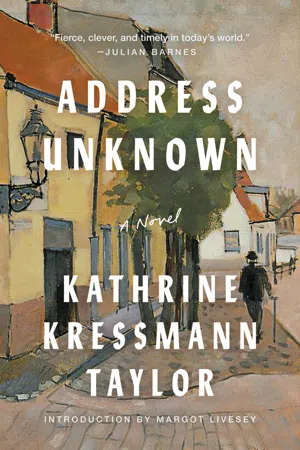Afterword
When Address Unknown was first published in the United States, in Story magazine in September 1938, it caused an immediate sensation. Written as a series of letters between a Jewish American living in San Francisco and his former business partner, returned to Germany, the story, early on, exposed the poison of Nazism to the American public.
Within ten days of publication, the entire printing of that issue of Story was sold out, and enthusiastic readers were mimeographing copies of the story to send to friends. National radio commentator Walter Winchell heartily recommended the story as ‘the best piece of the month, something you shouldn’t miss’, and Reader’s Digest put aside its long-standing no-fiction rule to reprint the piece for its more than three million readers.
In 1939, Simon & Schuster published Address Unknown as a book and sold 50,000 copies – a huge number in those years. Hamish Hamilton followed suit in England with a British edition, and foreign translations were begun. But 1939 was also the year of Blitzkrieg; within months most of Europe was under the domination of Adolf Hitler, the Dutch translation disappeared, and the only other European appearance of Address Unknown was on the Reichskommissar’s list of banned books. So the story remained unknown on the Continent for the next sixty years, despite its great impact and success in the US and England.
Author Kathrine Kressmann Taylor, ‘the woman who jolted America’, was born Kathrine Kressmann in Portland, Oregon, in 1903. After graduating from the University of Oregon in 1924, she moved to San Francisco and worked as an advertising copywriter, in her spare time writing for some small literary journals. In 1928 the editors of the San Francisco Review, a magazine she particularly liked, invited her to a party where she met Elliott Taylor, the owner of his own advertising agency, and they were married within two weeks. When the Great Depression put an end to the advertising industry, the couple bought a small farm in Southern Oregon, where they literally ‘lived off the land’, growing their own food and panning gold, taking their two small children and adding a third in 1935.
In 1938 they moved to New York, where Elliott worked as an editor, and Kathrine finished writing Address Unknown. Elliott showed it to Story magazine editor Whit Burnett, who immediately wished to publish it. He and Elliott decided that the story was ‘too strong to appear under the name of a woman’, and assigned Kathrine the literary pseudonym ‘Kressmann Taylor’, a professional name she accepted and kept for the rest of her life, largely because of the success of Address Unknown. This is how she describes the original motivation for the story:
When that incident occurred, it made only a small article in the news, but it caught Elliott’s eye; he brought it home to Kathrine, and it gave rise to their joint idea of using a letter as a weapon. She took that idea and went to work on the story she wanted to write.
The result was Address Unknown, a great success about which the New York Times Book Review stated in 1939, ‘This modern story is perfection itself. It is the most effective indictment of Nazism to appear in fiction.’ That indictment continued in her next book, Until That Day, published in 1942, and reissued as Day of No Return in 2003.
Following the war, when any further indictment of the Nazis seemed no longer necessary, Address Unknown slipped from public notice and was largely forgotten, other than its inclusion in an occasional anthology. Elliott Taylor died in 1953, and Kathrine lived as a widow for the next fifteen years, continuing to write and to teach writing, journalism, and humanities at Gettysburg College, in Pennsylvania. Retiring in 1966, she moved to Florence, Italy, where she experienced the great flood of the Arno river in November of that year which inspired her third book, Diary of Florence in Flood, published to critical acclaim in both England and America the following spring.
En route to Italy in 1966 on the Italian Line’s Michelangelo, Kathrine met the American sculptor John Rood. The two felt an immediate attraction, had a shipboard romance...
